A few years ago my sister sent me a text with a photo of 2 ZZ Plants – one the typical green shade that we’re all used to and one that was almost a black color.
“Have you ever seen these??” She texted me.
At initial glance the black one looked almost fake or like something was wrong with it since it’s wasn’t the typical green color. But nope, that’s exactly how it’s supposed to be because it’s a actually a Black Raven ZZ Plant (Zamioculcas zamiifolia Raven) not a standard one!
Today we’re going to share all that you need to know about this fun plant.
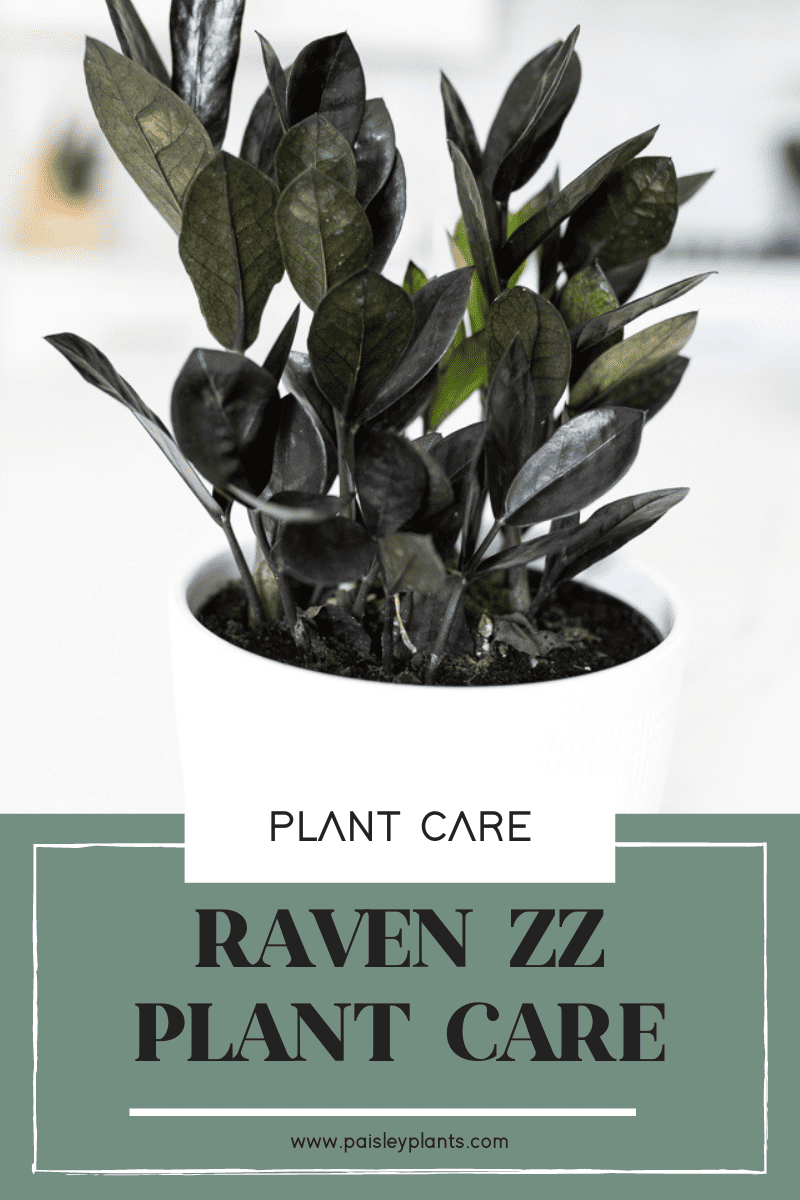
This post includes affiliate links.
Table of Contents
Raven ZZ Plant Background
The Raven ZZ plant made its debut in 2019 and today is considered one of the trendiest indoor plants on the market! It is native to Eastern Africa in parts of Kenya and South Africa.
The new leaves on the Raven ZZ Plant start out bright lime green, but eventually will turn a deep dark purple/black color. The only thing it takes for your plant to turn black is time! It may take up to two months for a stem and leaves to turn black completely, but usually it’s dark after 4-6 weeks.
One thing to keep in mind is that if you prune back the stems of your Raven ZZ plant, the new shoots will start out green again. If you wish to keep the entire plant a dark jet color, you need to not trim it back as often. This is just one way to keep the entire plant the same dark color overall.
It used to be a rare plant and difficult to acquire but now they are more readily available at most nurseries, plant shops, or even online. The ZZ in the name stands for Zamioculcas zamiifolia. You can probably understand why the name is shortened to just ZZ! That’s a mouthful!
Toxicity
Raven ZZ plants are considered toxic to both animals and humans. All parts of the ZZ plant is toxic, so should be kept away from your pets or small children to prevent any poisoning.
Raven ZZ Plant Care
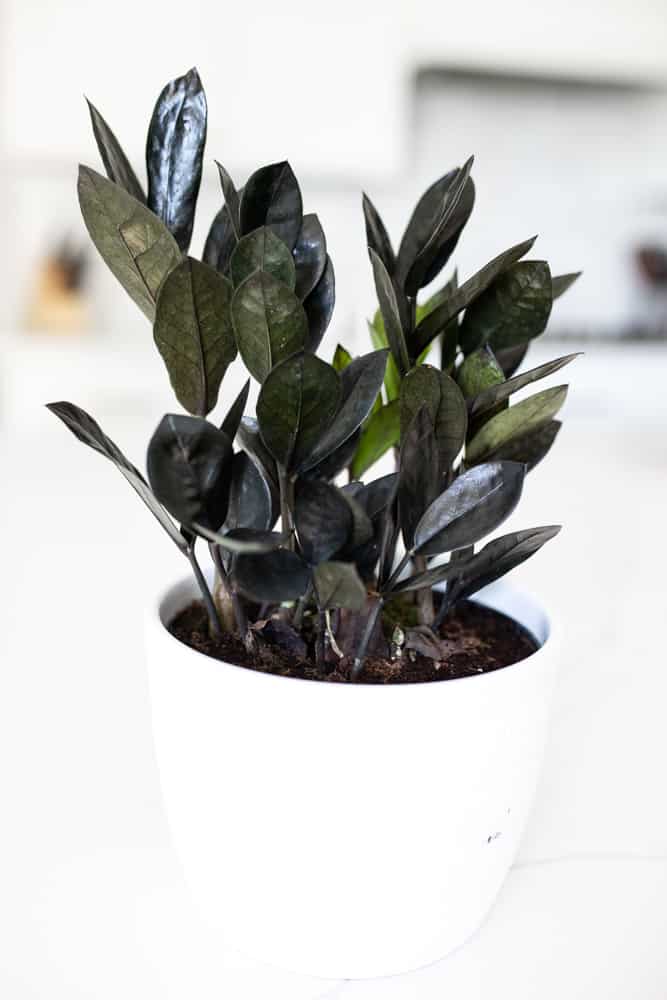
Water
This hardy plant has thick tuber-like rhizomes that store water which means it is drought tolerant and does not need to be watered frequently. In fact, these can go long periods of time without being watered making it a great choice for people who travel or who forget to water your plants. If you overwater it, this can lead to root rot, which will quickly kill a ZZ raven plant!
The best method of watering is the “soak and dry” method where you soak the soil and let it thoroughly dry out before you water it again. Keeping a regular watering schedule will ensure your plant has sufficient, but not too much moisture.
Light
Even though the ZZ plant can live in low light conditions, it will do best in medium to bright indirect light. Keep it in a minimum of six hours of indirect sunlight per day and it should be happy!
These plants will thrive in a south-facing window but just make sure it is out of reach of direct sunlight. Too much bright light is bad for these plants so using a sheer curtain to filter it is a great idea.
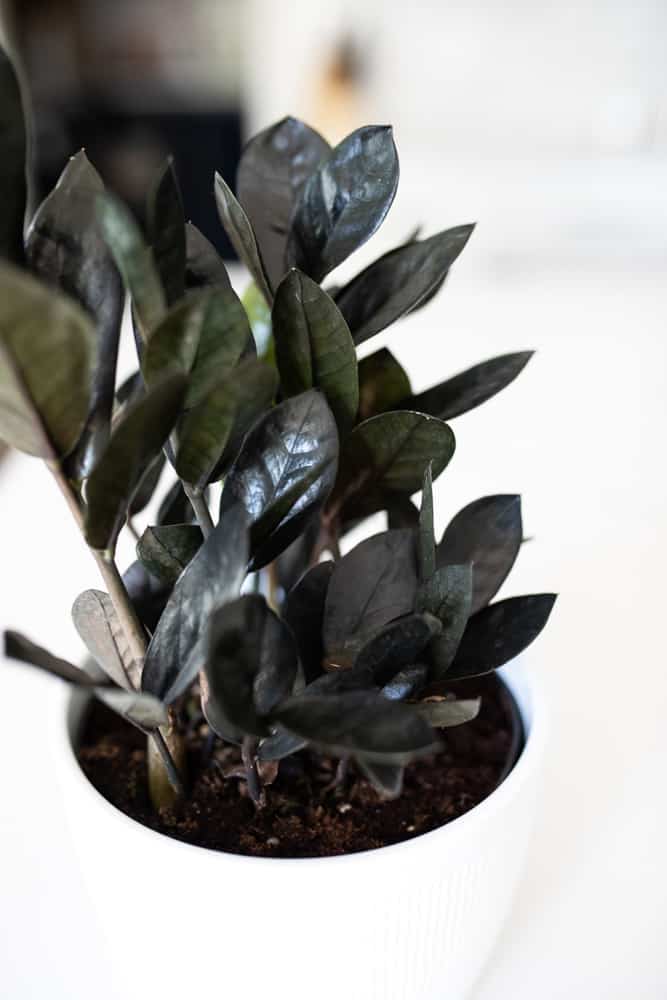
Soil
Using a well-draining soil or even a succulent style soil type will be best for your ZZ plant. If your soil is too heavy, you can add either perlite or sand to lighten it up.
Always be sure to have sufficient drainage holes in the pot you put your plant into. You need to have at least one good drainage hole in the bottom of your pot so excess water is able to drain properly.
Fertilizer
While the ZZ plant doesn’t necessarily need fertilizer, it will definitely benefit from regular fertilization during the active growing season. You should apply a balanced liquid fertilizer designed for houseplants once every three to four weeks to encourage strong, healthy growth.
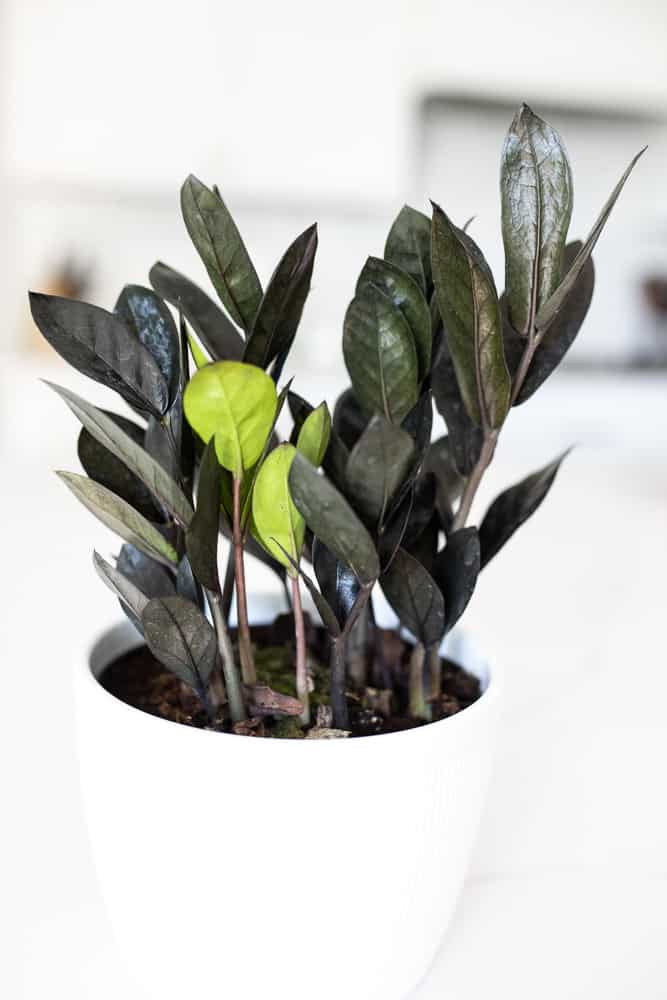
Temperature and Humidity
Your ZZ plant will grow best in temperatures between 60 and 75 degrees F. Average household humidity levels will suit it fine also. Be sure to keep your plant out of temperatures below 45 degrees F and consider placing your plant near a humidifier if the air in your house is on the dry side, especially in the winter months.
Pests and Diseases
The most common diseases the Raven ZZ plant will get are scale insects. These tiny insects are related to aphids and whiteflies, but they look very different. They will affix themselves to the ZZ plant and drink the sap.
While they drink, they grown a distinctive, scale like covering that gives them their common name. They are usually on the underside of the leaves. Treat this scale by wiping the bugs away with 70% isopropyl alcohol or soapy water using a soft toothbrush, cotton swabs or cotton balls. Check and clean every few days to prevent reinfestation.
These plants are also susceptible to aphids, mealybugs, whiteflies, mites, and fungus gnats. Using soapy water or insecticial soap will help treat aphids, mealybugs, and whiteflies. Wipe or spray the leaves to rid them of these pests.
Use a stream of lukewarm water to knock the mites (also known as spider mites) off the plants. Follow up by wiping the leaves with a soft cloth. If they persist, try using an insecticidal soap or neem oil.
Treat fungus gnats by controlling moisture and organic matter in the soil. You can use small yellow sticky traps that sit in plant containers. You can also place chunks of raw potato on the plant’s soil to attract the larvae. Remove the potato chunks every few days to reduce larvae populations, however.
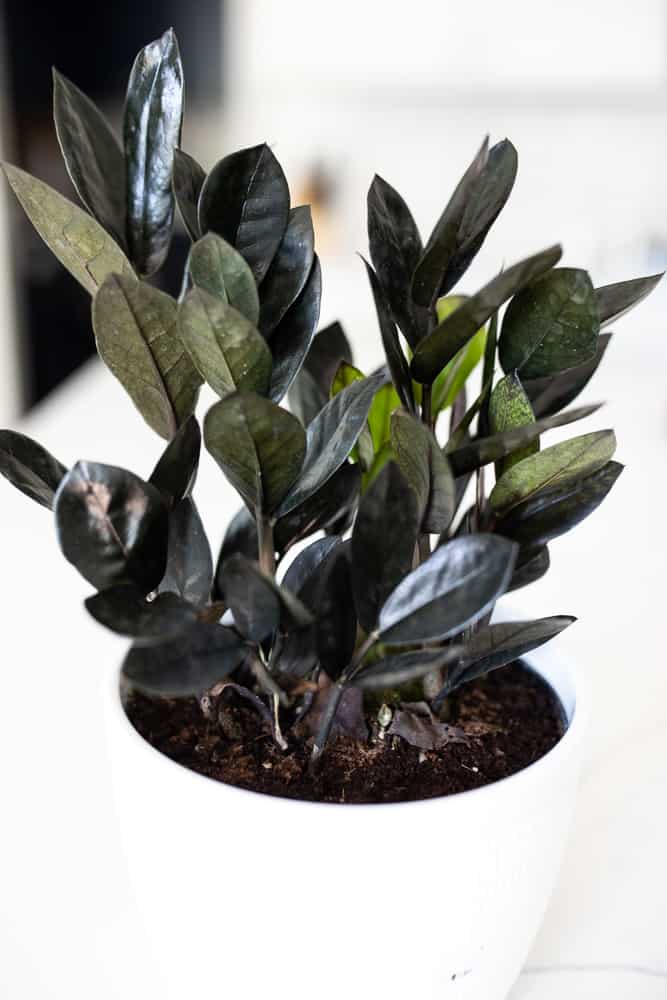
Pruning and Repotting
As I mentioned above, if you decide to prune your Raven ZZ plant often, you will need to remember that the new growth will grow out the light lime green color. It will need time to turn the deep dark purple/black color of the more mature parts of the plant. This, of course, will be your choice on how or when you prune your plant!
As far as repotting your Raven ZZ plant, you only need to do so about once a year. Don’t put it in too large of a pot if you do repot it or it will put most of its strength into the root growth.
The best time of year to repot your plant is in the spring when the new growing season begins. Once your ZZ plant gets a bit older, however, you won’t need to repot it but once every two to three years.
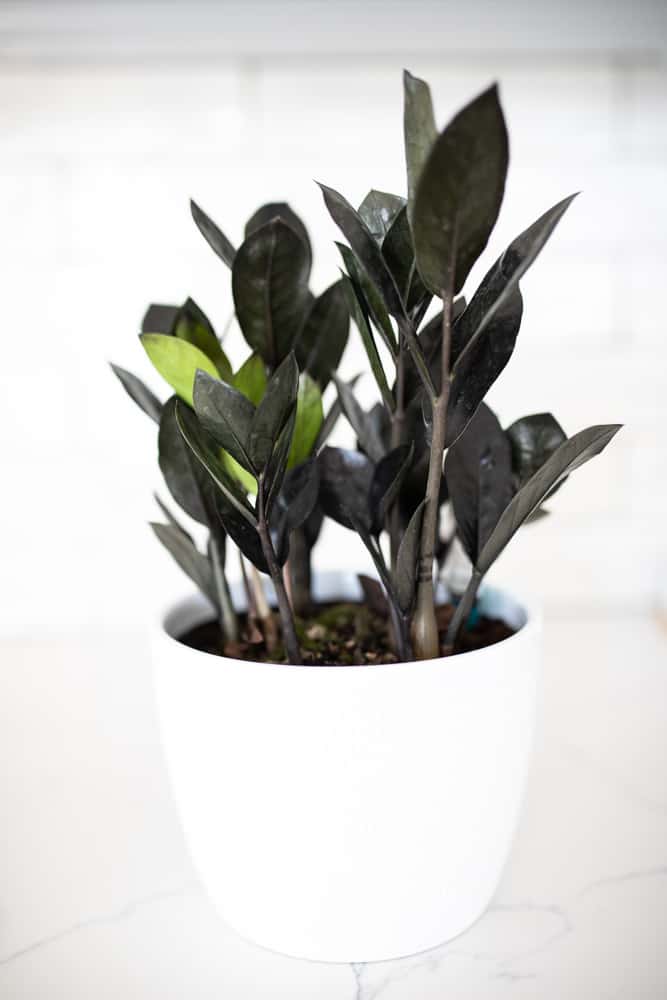
Common Problems
One common problem can be yellow leaves. This is mostly due to overwatering your plant. Be sure to not give your plant too much water, especially in the winter season when it is dormant.
Yellow leaves can also be due to excessive sunlight. Taking care to water properly and giving your plant the correct light conditions will help ensure this problem does not occur.
Brown leaf tips are also a common problem. This can be due to overwatering, especially if it is seen on new growth. Underwatering can also cause this, so keep an even watering schedule to help avoid this problem.
Where to Buy a Raven ZZ Plant
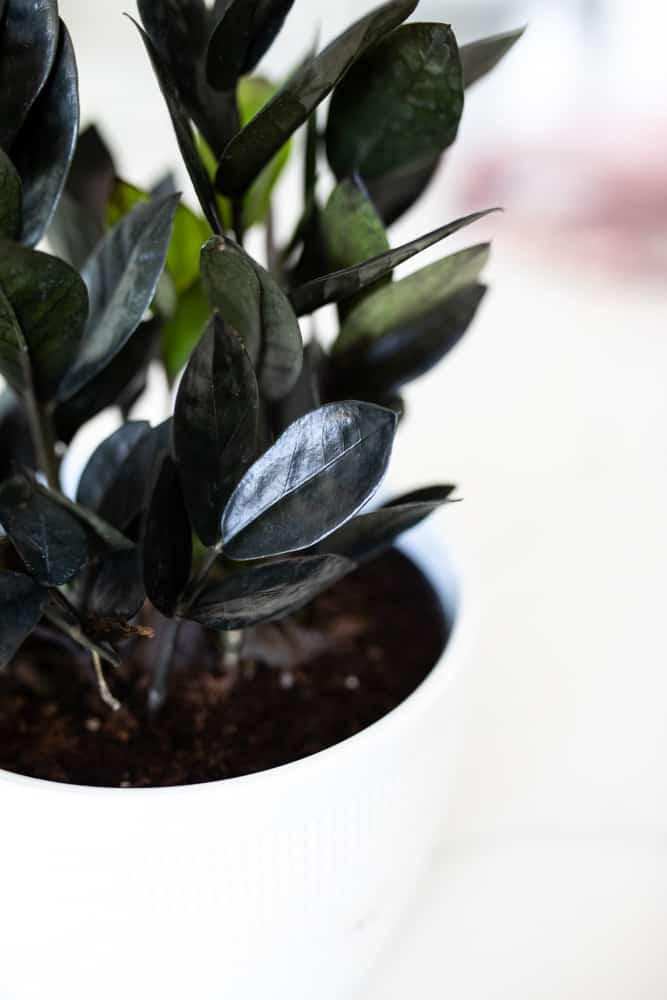
FAQs
These plants are poisonous to both humans and animals. They can also cause skin and eye irritation with direct contact, and can cause stomach upset, vomiting and diarrhea if ingested.
Some Feng Shui experts believe that the Raven ZZ plant must be grown indoors as it will attract protective and purifying energy. They believe keeping this plant in the southeastern corner of your home could bring more wealth and growth. It is also known to detoxify the air inside your home.
Many ZZ Plants will live five to 10 years! Their leaves will survive about six months or longer and even if you don’t water your ZZ plant, it can go about four months!
In Conclusion
Another thing that is important to know about the Raven ZZ Plant is that they are patent protected. That means that propagating these plants are prohibited by law, especially with the intention to sell. Their secrets are highly guarded and with the patent protection, it is imperative you don’t sell any you propagate!
If you decide to get one of these unique plants, it will definitely add a different look to your plant menagerie with its dark purple/black foliage! As always, keep on growing!
